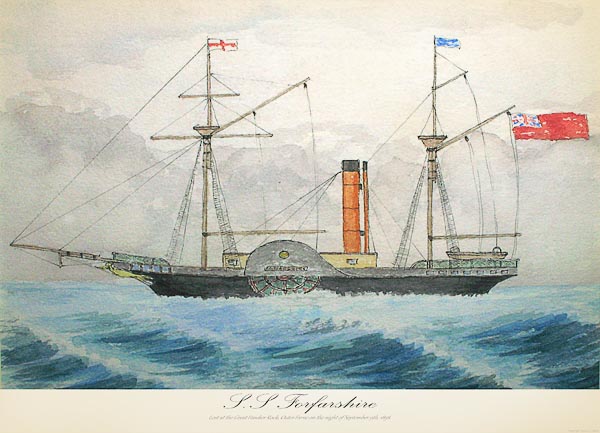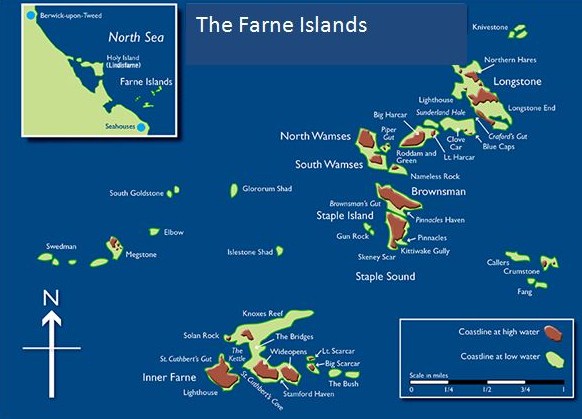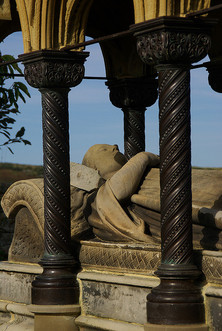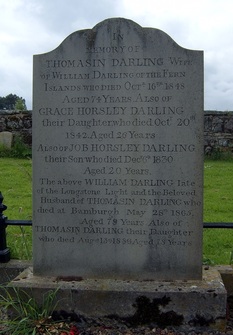IntroductionI am delighted that celebrated author Gary Dolman has written this fascinating and poignant insight into the lesser known aspects of the life of Grace Darling, whose selfless act of heroism in the rescue of passengers and crew of the stricken ship Forfarshire in 1838, and the ensuing publicity, hype and public adoration that in no small way contributed to her early demise in 1842 aged just 26 years old. I challenge you not to reach for your hankies! Gary's IntroductionIt is just over thirty-three years ago that Lady Diana Spencer, in her engagement to Prince Charles, was hurled into an inferno of public fame and adoration, eventually to be hounded to her death by the media. Next year – 2015 – will mark the two hundredth anniversary of the birth of arguably the first of all the media celebrities – the Northumbrian Grace Darling. Early LifeGrace was born in 1815 – the year of the Battle of Waterloo – into far humbler circumstances than the Honourable Diana Spencer. She was the seventh child of a lighthouse keeper, born in an estate cottage in Bamburgh village and brought up in the lighthouse of Brownsman Island, one of the nearby Farne Islands. 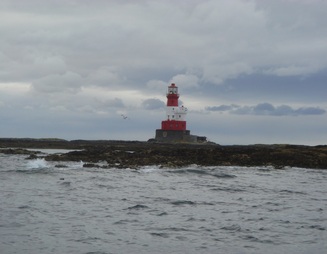 The Longstone Lighthouse. Grace’s window was that at the top of the white ring. The Longstone Lighthouse. Grace’s window was that at the top of the white ring. At the age of ten, Grace moved with her family to a newly-constructed lighthouse on the Longstone rock, built to warn the rapidly increasing shipping of the dangerous outermost rocks of the Farnes group. She never attended school, but instead was taught in scriptural and secular matters by her father, William Darling, up in the lighthouse lantern. Hers was a quiet and gentle existence, isolated except for occasional visitors to the island and trips to Bamburgh. On the morning of Friday, 7th September 1838, however, all that was to change forever. The ForfarshireTwo days earlier, the paddle-steamship SS Forfarshire (450 Tons) had sailed from Hull with passengers and a full cargo bound for Dundee. There were around forty cabin and deck passengers on board, (although a complete passenger list was never made) and twenty-two crew plus the Captain, John Humble and his wife. Whilst docked at Hull, the ship's boilers had been inspected and repairs made. However, the boilers continued to give cause for concern from early in the voyage, leaking and losing pressure continually and there was much talk that the Forfarshire should head for one of the River Tyne ports for repair especially as the seas were heavy. The captain assured passengers there was nothing to be concerned about. By early evening on Thursday, 6th September they passed the Farne Islands but by now the condition of the boilers meant that the crew were forced to raise sail to assist passage. As the ship passed Berwick-upon-Tweed the weather quickly deteriorated and the wind rose into a Northerly gale. The extra pressure exerted on the boilers caused them to fail completely and the engines were stopped. Under pressure of wind and current, the Forfarshire began to drift south. At 1.00 am on Friday, 7th September and now under sail in an increasing storm, Captain Humble gave the order to turn back, intending to seek shelter near the Farnes. After a difficult period negotiating rapidly changing tidal currents and with the big paddle-boxes catching the swell and making navigation extremely difficult, the light of a lighthouse was seen. Captain Humble identified it as the lighthouse of the Inner Farne and intending to find shelter in Fairway, (the relatively slack water between this island and the coast) he kept the lighthouse to his port bow. He had made a catastrophic mistake. The light he had seen had not been that on Inner Farne but on the Longstone, much further out, and in keeping it to port, he was in fact steering straight for the rocks. 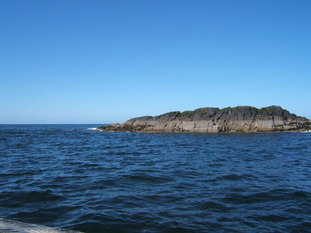 Big Harcar Big Harcar At 4.00am the ship hit the Big Harcar Rock. Immediately the crew lowered the quarter-boat and eight of them jumped in. The swift current and winds through the Piper Gut channel carried them away from the wreck and into the relative safety of the open sea. The Forfarshire lurched back and struck the rock again and the vessel split in two. The front portion became stuck fast but the after-part, together with the cargo and all below deck was lost to the sea. The Forfarshire lurched back and struck the rock again and the vessel split in two. The front portion became stuck fast but the after-part, together with the cargo and all below deck was lost to the sea. 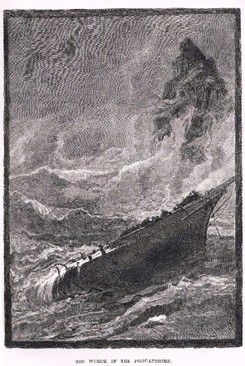 There were a few however who had survived on the deck, clinging to anything they could find. To make matters worse, the tide was now falling, causing the wreck to become unstable. The survivors scrambled onto the rock, including a Mrs Sarah Dawson, with her two children and they also brought out the corpse of another passenger, a Reverend Robb, deciding to save his body from the sea. That night, Grace and her parents were in the lighthouse. Grace, unable to sleep, was watching the storm from her bedroom window. Through the darkness she saw a large, black shape on Harcar Rock – a ship – and ran to wake her father. Through a telescope, they studied the wreck for signs of life and at this point saw none. Grace continued to watch and as daylight swelled, at around 7.00am, she saw movement. There were what looked to be three or four survivors after all. William Darling thought the sea too rough for the North Sunderland (Seahouses) lifeboat to put out even if the wreck had been spied from the look-out point on Bamburgh Castle at all, and so Grace pleaded with him that they take their own coble to attempt to rescue them. Thomasin, Grace’s mother was against it – afraid they would both be drowned and William himself was dubious. Grace however, was insistent. Two people at least were needed to handle the 20ft boat so both William and Grace made haste to launch it. Almost immediately they disappeared from view and poor Thomasin thought they were lost. They were not however. William had decided to take the southerly course around Blue Caps and Clove Car to Big Harcar. It was the long way round, nearly a mile in distance, but much more sheltered. Nevertheless the gale, the swell, the noise and the sheer physical effort involved must have been incredible. Eventually they fought their way to the wreck and instead of the handful of survivors they expected, there were, mercifully, no fewer than nine. William realised that two trips were now required. 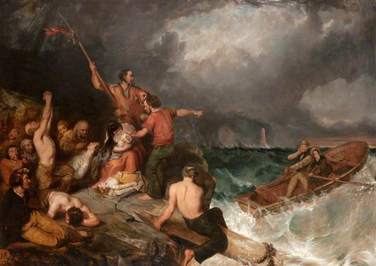 The Rescue The Rescue He leapt across onto the Big Harcar rock while Grace somehow held the coble steady. Mrs Dawson’s two small children were dead and William had to insist that they were left behind along with the Reverend Robb’s corpse. An injured passenger was also taken, along with two crew members to help row the coble. Grace presumably would have comforted Mrs Dawson and nursed the injured man as best she could. They arrived safely at Longstone and William returned with the two crewmen to collect the remaining crewman and three passengers. The three bodies were left, to collect when it was safer to do so. AftermathThe story of the rescue immediately made the local, and then the national newspapers, who made much of how, against all odds, Grace had been able to save nine souls from the wreck. The part played by William Darling was largely forgotten in the frenzy, as was that that of the North Sunderland lifeboat crew who did in fact put to sea and who rowed through the storm for over five hours, eventually arriving at Harcar not long after the Darlings. Gifts, awards and donations for Grace came flooding in. Silks, silverware, books and bibles arrived from admirers across the country and even from abroad. Queen Victoria, herself only nineteen, sent Grace £50. Hundreds of letters were sent to Longstone, many requested her autograph, locks of her hair or a piece of the clothing she wore during the rescue. 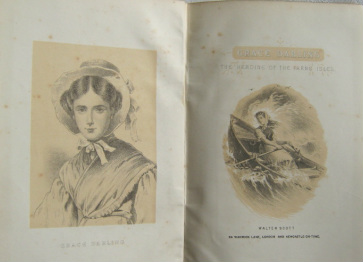 The Heroine of The Farne Isles - Sir Walter Scott The Heroine of The Farne Isles - Sir Walter Scott Along with the letters came visitors, arriving every day in hired boats hoping to meet or see Grace or simply to stand and stare at her. Her image became hugely popular and artists arrived regularly to paint her likeness. These likenesses, of an ordinary young woman with ‘windswept hair’, sealed it. She became the romantic heroine of the age. Books were written about her; often fictional accounts, which bore little resemblance to the actual events; poems were penned by no lesser writers than Wordsworth and Swinburne; songs sung and even theatrical dramatisations performed in great London theatres. Floods of cheap souvenirs were made and Cadbury even produced a range of ‘Grace Darling’ chocolates. What was initially thrilling for Grace soon became onerous and then quite overwhelming. She was used to a simple, quiet and ordered life. Now, there was constant pressure to attend functions and to receive awards and honours, to respond to letters and to receive visitors. 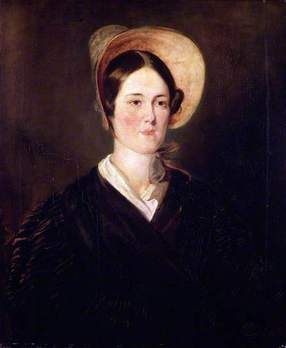 Each morning, she would see a flotilla of boats setting out from Bamburgh, Seahouses and Beadnell and not know which would be fishermen and which would be hired boats coming to see her. She began to suffer and to withdraw into herself, refusing invitations and being racked with guilt at the offence she might have caused by doing so. In an attempt to deflect the adulation she was receiving, Grace began to say that it was God who had given her the strength to carry out the rescue. This only made matters worse. The Church leapt onto it and many clergymen and representatives were sent to visit and write to her, wanting to meet to reflect on matters spiritual. The public’s obsession with Grace Darling did not diminish a degree right up what tragically became her last year of life. In 1842, her brother William Brooks Darling was appointed assistant lighthouse keeper to their father at Longstone. In order to accommodate his wife and family, cottages had to be built beside the lighthouse. Not only were there many workmen present on the island whilst construction was taking place, William Brooks’ family also had to move into the lighthouse. Their sister Mary Ann, a widow, had already moved back to Longstone with her daughter and Grace had no privacy, nowhere to hide away, even in what was her own home. 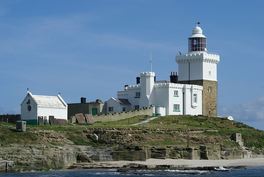 Coquet Island Coquet Island It was decided that Grace needed time away from the bustle and in March she went to Coquet Island where her eldest brother, William, was keeper of the lighthouse. Her short appearance at Seahouses harbour in boarding the steamer caused a sensation and Grace had to hide below deck From Coquet Island she went to Alnwick where she stayed with her cousins before returning to Longstone. She caught a virus during this time and developed a persistent cough. Throughout that summer the visitor numbers to Longstone were unrelenting. This together with endless letter-writing and replying to invitations took its toll on Grace and she withdrew yet further into herself, eventually becoming ill and weak. In September 1842, Grace was sent to Wooler to stay with friends. In this short time she did improve a little and even rode a pony into the Cheviot Hills, but then it was decided to return her to Alnwick, to the cramped and crowded Narrowgate. Here, Grace rapidly declined once more so she was moved again to a quieter house in Prudhoe Street. There the Duchess of Northumberland sent the Duke's personal physician to attend on her. He diagnosed tuberculosis. The deeply concerned Duchess visited her bedside but this only caused poor Grace further distress. Mental DeclineGrace mental health suffered. She began to have psychotic experiences of staring eyes and of crowds outside her window, and paranoid delusions that everyone was finding fault with her. She grew deeply anxious and depressed, becoming feverish and increasingly weak. As her sister Thomasin wrote of her at this time; “she went like the snow.” 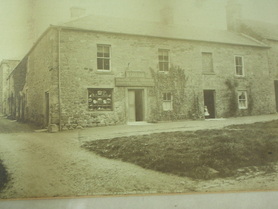 Her father decided to return her to Bamburgh village, to her uncle’s home, where he hoped the familiar surroundings would calm her. However, in the event, it only made matters worse. Every knock at the door from well-wishers, every sound she heard caused her anguish and distress. She lay in a box bed, with a sliding wall panel, shut away from the world, scarcely getting up and clearly profoundly depressed. Grace began to realise that the end from tuberculosis was close. She asked for her family to be summoned and from her deathbed Grace distributed personal items to her relatives. She was quite calm and composed at this time. I believe that the knowledge that she was dying and that the unrelenting pressure would soon be over was a blessed relief to her. On the evening of Thursday, 20th October 1842, Grace Darling asked to be raised up from her pillow. She died in her father’s arms at 8.15pm. She was just twenty-six years old. The story of the Darlings’ rescue of the survivors of the wreck of the Forfarshire is a very well known one. Much less so is that of Grace’s inability to cope with the fame and attention it threw up. It demonstrates powerfully how mental disorder can affect even the strongest and most heroic of people and that anyone can be affected given a particular set of circumstances. I believe that tragic though it was, Grace Darling’s suffering and decline is testament to her humanity as well as her courage. ConclusionHer fame and adoration was unintended and uninvited. Many thanks to Gary who has described in such a sympathetic manner how this affected both her mental and physical decline, and illustrated how both can go hand in hand. To find out more about Gary Dolman and to buy his books "Red Dragon, White Dragon" and "The Eighth Circle of Hell" both of which I can thoroughly recommend visit http://garydolman.blogspot.co.uk/p/eighth-circle-of-hell.html
7 Comments
|
AuthorSusie Douglas Archives
August 2022
Categories |
Copyright © 2013 Borders Ancestry
Borders Ancestry is registered with the Information Commissioner's Office No ZA226102 https://ico.org.uk. Read our Privacy Policy
